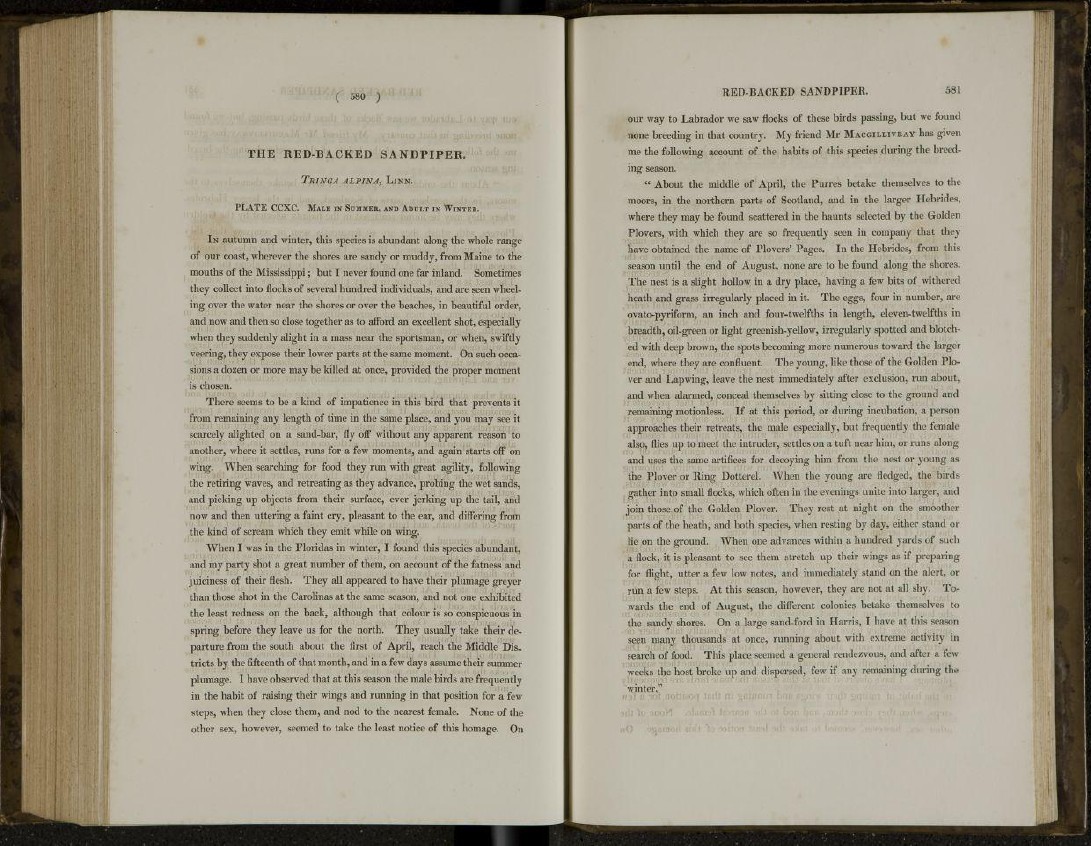
( 580 )
THE RED-BACKED SANDPIPER.
TRINGA ALPINA, LINN.
P L A T E C C X C . MALE IN SUMMER, AND ADULT IN WINTEH.
IN autumn and winter, this species is abundant along the whole range
of our coast, wherever the shores are sandy or muddy, from Maine to the
mouths of the Mississippi; but I never found one far inland. Sometimes
they collect into flocks of several hundred individuals, and are seen wheeling
over the water near the shores or over the beaches, in beautiful order,
and now and then so close together as to afford an excellent shot, especially
when they suddenly alight in a mass near the sportsman, or when, swiftly
veering, they expose their lower parts at the same moment. On such occasions
a dozen or more may be killed at once, provided the proper moment
ii/orJB nut tiUHzutiX'j vMis. yloi&immmi Jgun s i l t svj&al .BrriwqBj bn& VJV
is chosen.
There seems to be a kind of impatience in this bird that prevents it
from remaining any length of time in the same place, and you may see it
scarcely alighted on a sand-bar, fly off without any apparent reason to
another, where it settles, runs for a few moments, and again starts off on
wing. When searching for food they run with great agility, following
the retiring waves, and retreating as they advance, probing the wet sands,
and picking up objects from their surface, ever jerking up the tail, and
now and then uttering a faint cry, pleasant to the ear, and differing from
the kind of scream which they emit while on wing.
When I was in the Floridas in winter, I found this species abundant,
and my party shot a great number of them, on account of the fatness and
juiciness of their flesh. They all appeared to have their plumage greyer
than those shot in the Carolinas at the same season, and not one exhibited
the least redness on the back, although that colour is so conspicuous in
spring before they leave us for the north. They usually take their departure
from the south about the first of April, reach the Middle Districts
by the fifteenth of that month, and in a few days assume their summer
plumage. I have observed that at this season the male birds are frequently
in the habit of raising their wings and running in that position for a few
steps, when they close them, and nod to the nearest female. None of the
other sex, however, seemed to take the least notice of this homage. On
RED-BACKED SANDPIPER. 581
our way to Labrador we saw flocks of these birds passing, but we found
none breeding in that country. My friend Mr MACGILLIVRAY has given
me the following account of the habits of this species during the breeding
season.
" About the middle of April, the Purres betake themselves to the
moors, in the northern parts of Scotland, and in the larger Hebrides,
where they may be found scattered in the haunts selected by the Golden
Plovers, with which they are so frequently seen in company that they
have obtained the name of Plovers' Pages. In the Hebrides, from this
season until the end of August, none are to be found along the shores.
The nest is a slight hollow in a dry place, having a few bits of withered
heath and grass irregularly placed in it. The eggs, four in number, are
ovato-pyriform, an inch and four-twelfths in length, eleven-twelfths in
breadth, oil-green or light greenish-yellow, irregularly spotted and blotched
with deep brown, the spots becoming more numerous toward the larger
end, where they are confluent. The young, like those of the Golden Plover
and Lapwing, leave the nest immediately after exclusion, run about,
and when alarmed, conceal themselves by sitting close to the ground and
remaining motionless. If at this period, or during incubation, a person
approaches their retreats, the male especially, but frequently the female
also, flies up to meet the intruder, settles on a tuft near him, or runs along
and uses the same artifices for decoying him from the nest or young as
the Plover or Ring Dotterel. When the young are fledged, the birds
gather into small flocks, which often in the evenings unite into larger, and
join those of the Golden Plover. They rest at night on the smoother
parts of the heath, and both species, when resting by day, either stand or
lie on the ground. When one advances within a hundred yards of such
a flock, it is pleasant to see them stretch up their wings as if preparing
for flight, utter a few low notes, and immediately stand on the alert, or
run a few steps. At this season, however, they are not at all shy. Tor
wards the end of August, the different colonies betake themselves to
the sandy shores. On a large sand-ford in Harris, I have at this season
seen many thousands at once, running about with extreme activity in
search of food. This place seemed a general rendezvous, and after a few
weeks the host broke up and dispersed, few if any remaining during the
winter."